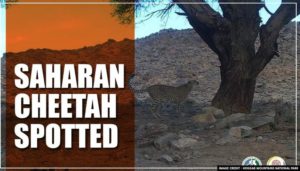
Critically Endangered Saharan Cheetah Spotted For The First Time In A Decade
Naturalists in Algeria have filmed a Saharan Cheetah, which is a subspecies that have been listed as critically endangered on the International Union of Conservation (IUCN) Red List, for the first time in a decade.
The Saharan Cheetah is one of the most elusive wild cats in the world.
They have a different appearance from the African Cheetahs, its coat is shorter and has a paler color.
The very rare animal was spotted in the Hoggar Mountains National Park in the very desert south of Algeria.
The news was announced by Salah Amokrane, an official that works with the Hoggar Mountains National Park.
Images of the cheetah were taken in the Atakor volcanic field whose peaks approach a height of 3,000 metres (9,800 feet).
The national park released a photograph of the very rare Saharan cheetah sighting on Facebook:
الفهد الصحراوي في الحظيرة الثقافية للاهقار بعد اخر رصد له منذ اكثر من 10 سنوات هذا الحيوان ضمن الحيوانات المهددة بالانقراض مما يستوجب حمايته و المحافظة عليه.
Posted by Office National Du Parc Culturel De l'Ahaggar on Wednesday, 20 May 2020
On May 25, 2020, the scientists of the national park released a documentary of their work, which includes a picture of the rare cat caught on cam.
The images were shared on Facebook and became a very viral picture.
Susanta Nanda, an Indian Forest Service Officer, shared the image on Twitter, where he revealed that there are only 37 of them remaining out there in the wild.
The most elusive wild cat in the world-the Sahara Cheetah- was spotted after a decade in Algeria.Only 37 of them are left in the wild.
Snow leopard is difficult to spot in the wild. But it was a surprise when 3 of them were seen at Almaty town of Khazakisthan during lockdown. pic.twitter.com/fKqSNOPZZ3— Susanta Nanda IFS (@susantananda3) May 26, 2020
The Saharan Cheetah’s range is only limited to isolated pockets across the Sahara Desert and Sahel from Mali, which is located in the West to the Central African Republic in the east.
The subspecies was last seen in the Hoggar Mountains in 2008 to 2010 when four individuals were recorded by camera traps.